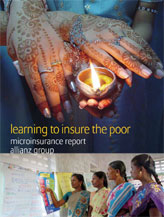The new report is based on research, conducted in collaboration with the Emergia Institute, to consolidate the wealth of insights Allianz has gained in the first years of developing its microinsurance business. Key facts on the state of microinsurance today, case studies on existing Allianz microinsurance projects and perspectives from experts on the future of microinsurance round out the report.
"Learning to insure the poor"
Download
Today, half of the world's population comprises the market for microinsurance. Four billion people live on incomes of less than eight dollars per day. Of that number, 2.6 billion get by on less than two dollars per day. With few assets, these individuals are more vulnerable to risk and less able to cope with loss. Shocks like natural disaster, loss of property or harvests, and the illness or death of a family's breadwinner can quickly lead to destitution.

A learning process
Microinsurance could be a part of the remedy. Premiums are small enough to afford, and microinsurance provides protection against loss to those who need it most, when they need it most. Yet, while micro-loans are more widely understood and widespread in developing countries, the concept of microinsurance is not as familiar. From the provider perspective, it is often considered to be too complex and cost-intensive to be marketed successfully in the world's poorest rural regions.
Not so, according to Allianz. The company first began to look into the market of low-income households six years ago. In 2004, it launched a small credit life insurance portfolio in India. Fast forward to today and Allianz has sold life insurance, property insurance and health insurance to 3.8 million microinsurance customers in India, Indonesia, Africa and Latin America. In June, Allianz announced that it will launch a microinsurance division in Brazil next year, citing a rapidly growing microinsurance market in the country with potentially 50 to 60 million Brazilians needing life and housing coverage.
Despite this success, Allianz still sees insuring the poor as a learning process. A considerable number of challenges remain unresolved, such as how to calculate risks in the absence of data, how to sell and administer policies efficiently and how to get more people, who live in deep poverty, to understand insurance benefits and to invest in them.
As with all content published on this site, these statements are subject to our Forward Looking Statement disclaimer.
Link to the disclaimer